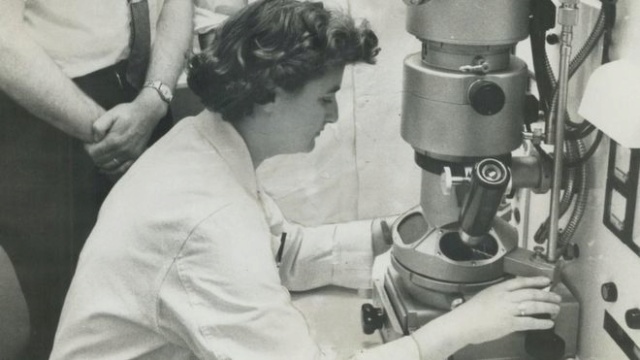The woman who discovered the first coronavirus
Page 1 of 1
 The woman who discovered the first coronavirus
The woman who discovered the first coronavirus

The woman who discovered the first human coronavirus was the daughter of a Scottish bus driver, who left school at 16.
June Almeida went on to become a pioneer of virus imaging, whose work has come roaring back into focus during the present pandemic.
Covid-19 is a new illness but it is caused by a coronavirus of the type first identified by Dr Almeida in 1964 at her laboratory in St Thomas's Hospital in London.
The virologist was born June Hart in 1930 and grew up in a tenement near Alexandra Park in the north east of Glasgow.
She left school with little formal education but got a job as a laboratory technician in histopathology at Glasgow Royal Infirmary.
Later she moved to London to further her career and in 1954 married Enriques Almeida, a Venezuelan artist.
Common cold research
The couple and their young daughter moved to Toronto in Canada and, according to medical writer George Winter, it was at the Ontario Cancer Institute that Dr Almeida developed her outstanding skills with an electron microscope.
She pioneered a method which better visualised viruses by using antibodies to aggregate them.
Mr Winter told Drivetime on BBC Radio Scotland her talents were recognised in the UK and she was lured back in 1964 to work at St Thomas's Hospital Medical School in London, the same hospital that treated Prime Minister Boris Johnson when he was suffering from the Covid-19 virus.
On her return, she began to collaborate with Dr David Tyrrell, who was running research at the common cold unit in Salisbury in Wiltshire.
Mr Winter says Dr Tyrrell had been studying nasal washings from volunteers and his team had found that they were able to grow quite a few common cold-associated viruses but not all of them.
One sample in particular, which became known as B814, was from the nasal washings of a pupil at a boarding school in Surrey in 1960.
They found that they were able to transmit common cold symptoms to volunteers but they were unable to grow it in routine cell culture.
However, volunteer studies demonstrated its growth in organ cultures and Dr Tyrrell wondered if it could be seen by an electron microscope.
They sent samples to June Almeida who saw the virus particles in the specimens, which she described as like influenza viruses but not exactly the same.
She identified what became known as the first human coronavirus.
More here: https://www.bbc.co.uk/news/uk-scotland-52278716

eddie- King of Beards. Keeper of the Whip. Top Chef. BEES!!!!!! Mushroom muncher. Spider aficionado!
- Posts : 43129
Join date : 2013-07-28
Age : 24
Location : England
 Similar topics
Similar topics» Woman climbs on police car, strips naked in protest of coronavirus restrictions
» Portland woman accused of rioting faces both local and federal charges (This is not a woman)
» Woman Claimed Boyfriend Raped Her 14 Times - Woman Sentenced To 4 Years
» Crazy Black Woman Shoots Pregnant Woman In Stomach Killing Her Unborn Baby - Over FACEBOOK POST!
» Body cam video catches Barstow cops slamming black pregnant woman to ground, letting white woman go free
» Portland woman accused of rioting faces both local and federal charges (This is not a woman)
» Woman Claimed Boyfriend Raped Her 14 Times - Woman Sentenced To 4 Years
» Crazy Black Woman Shoots Pregnant Woman In Stomach Killing Her Unborn Baby - Over FACEBOOK POST!
» Body cam video catches Barstow cops slamming black pregnant woman to ground, letting white woman go free
Page 1 of 1
Permissions in this forum:
You cannot reply to topics in this forum
» TOTAL MADNESS Great British Railway Journeys among shows flagged by counter terror scheme ‘for encouraging far-right sympathies
» Interesting COVID figures
» HAPPY CHRISTMAS.
» The Fight Over Climate Change is Over (The Greenies Won!)
» Trump supporter murders wife, kills family dog, shoots daughter
» Quill
» Algerian Woman under investigation for torture and murder of French girl, 12, whose body was found in plastic case in Paris
» Wind turbines cool down the Earth (edited with better video link)
» Saying goodbye to our Queen.
» PHEW.
» And here's some more enrichment...
» John F Kennedy Assassination
» Where is everyone lately...?
» London violence over the weekend...
» Why should anyone believe anything that Mo Farah says...!?
» Liverpool Labour defends mayor role poll after turnout was only 3% and they say they will push ahead with the option that was least preferred!!!
» Labour leader Keir Stammer can't answer the simple question of whether a woman has a penis or not...
» More evidence of remoaners still trying to overturn Brexit... and this is a conservative MP who should be drummed out of the party and out of parliament!
» R Kelly 30 years, Ghislaine Maxwell 20 years... but here in UK...